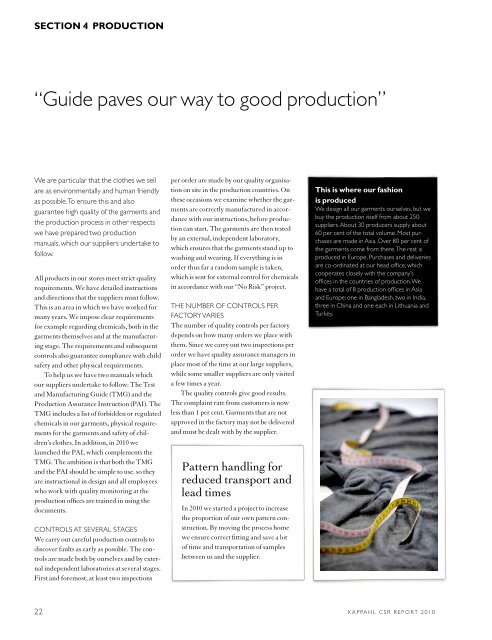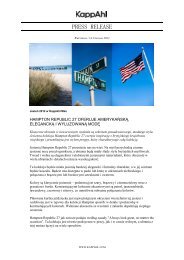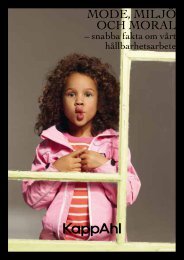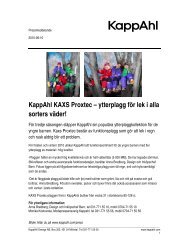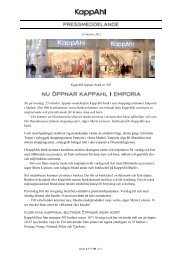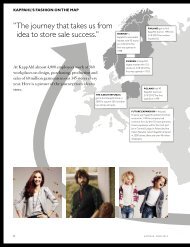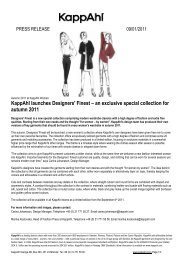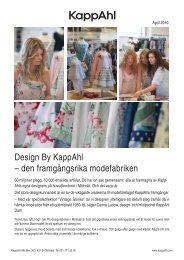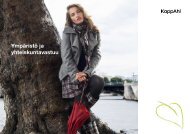Corporate Social Responsibility Report - KappAhl
Corporate Social Responsibility Report - KappAhl
Corporate Social Responsibility Report - KappAhl
You also want an ePaper? Increase the reach of your titles
YUMPU automatically turns print PDFs into web optimized ePapers that Google loves.
SECTION 4 PRODUCTION<br />
“Guide paves our way to good production”<br />
We are particular that the clothes we sell<br />
are as environmentally and human friendly<br />
as possible. To ensure this and also<br />
guarantee high quality of the garments and<br />
the production process in other respects<br />
we have prepared two production<br />
manuals, which our suppliers undertake to<br />
follow.<br />
All products in our stores meet strict quality<br />
requirements. We have detailed instructions<br />
and directions that the suppliers must follow.<br />
This is an area in which we have worked for<br />
many years. We impose clear requirements<br />
for example regarding chemicals, both in the<br />
garments themselves and at the manufacturing<br />
stage. The requirements and subsequent<br />
controls also guarantee compliance with child<br />
safety and other physical requirements.<br />
To help us we have two manuals which<br />
our suppliers undertake to follow: The Test<br />
and Manufacturing Guide (TMG) and the<br />
Production Assurance Instruction (PAI). The<br />
TMG includes a list of forbidden or regulated<br />
chemicals in our garments, physical requirements<br />
for the garments and safety of children’s<br />
clothes. In addition, in 2010 we<br />
launched the PAI, which complements the<br />
TMG. The ambition is that both the TMG<br />
and the PAI should be simple to use. so they<br />
are instructional in design and all employees<br />
who work with quality monitoring at the<br />
production offices are trained in using the<br />
documents.<br />
CONTROLS AT SEVERAL STAGES<br />
We carry out careful production controls to<br />
discover faults as early as possible. The controls<br />
are made both by ourselves and by external<br />
independent laboratories at several stages.<br />
First and foremost, at least two inspections<br />
per order are made by our quality organisation<br />
on site in the production countries. On<br />
these occasions we examine whether the garments<br />
are correctly manufactured in accordance<br />
with our instructions, before production<br />
can start. The garments are then tested<br />
by an external, independent laboratory,<br />
which ensures that the garments stand up to<br />
washing and wearing. If everything is in<br />
order thus far a random sample is taken,<br />
which is sent for external control for chemicals<br />
in accordance with our “No Risk” project.<br />
THE NUMBER OF CONTROLS PER<br />
FACTORY VARIES<br />
The number of quality controls per factory<br />
depends on how many orders we place with<br />
them. Since we carry out two inspections per<br />
order we have quality assurance managers in<br />
place most of the time at our large suppliers,<br />
while some smaller suppliers are only visited<br />
a few times a year.<br />
The quality controls give good results.<br />
The complaint rate from customers is now<br />
less than 1 per cent. Garments that are not<br />
approved in the factory may not be delivered<br />
and must be dealt with by the supplier.<br />
Pattern handling for<br />
reduced transport and<br />
lead times<br />
In 2010 we started a project to increase<br />
the proportion of our own pattern construction.<br />
By moving the process home<br />
we ensure correct fitting and save a lot<br />
of time and transportation of samples<br />
between us and the supplier.<br />
This is where our fashion<br />
is produced<br />
We design all our garments ourselves, but we<br />
buy the production itself from about 250<br />
suppliers. About 30 producers supply about<br />
60 per cent of the total volume. Most purchases<br />
are made in Asia. Over 80 per cent of<br />
the garments come from there. The rest is<br />
produced in Europe. Purchases and deliveries<br />
are co-ordinated at our head office, which<br />
cooperates closely with the company’s<br />
offices in the countries of production. We<br />
have a total of 8 production offices in Asia<br />
and Europe: one in Bangladesh, two in India,<br />
three in China and one each in Lithuania and<br />
Turkey.<br />
22 K A P PA H L C S R R e P O RT 2 0 1 0


